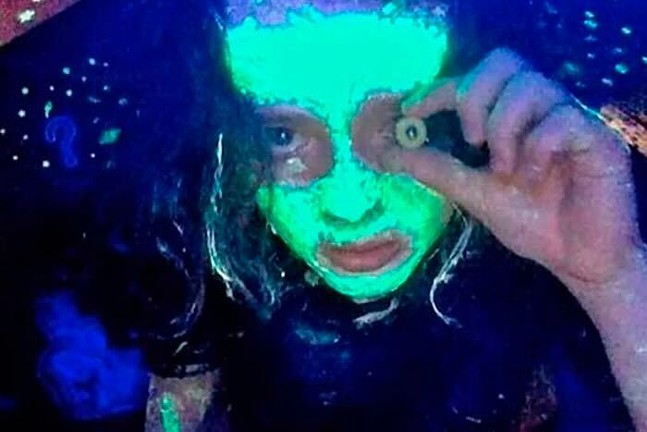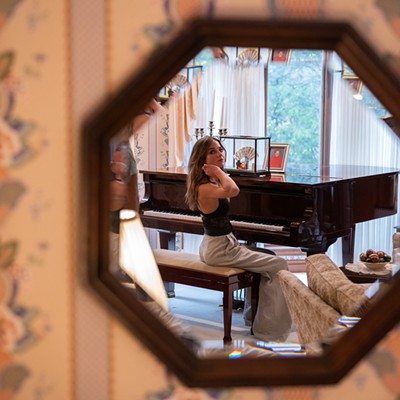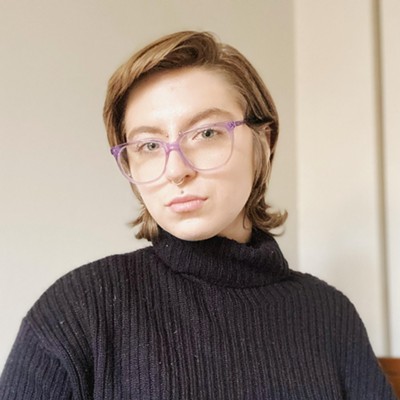Trans filmmaker explores dysphoria through internet horror in We're All Going to the World's Fair
I have to start by confessing something: I don’t remember a time before the internet. I was born right before the turn of the century, something that lands me right on the edge of the more-arbitrary-than-not divide between Millennials and Zoomers. But if there is anything that solidly separates the two generations, it must be questions of how much the internet has structured your life. Do you remember a time before the internet? What is your online life like? What does it even mean to have an “online” life, anyways?
These questions are at the heart of many recent works of literary fiction, but in film, they’ve been mostly limited to the Wachowski sisters’ Matrix films, an extraordinarily bad Jason Reitman film, and the Unfriended horror series. Enter Jane Schoenbrun’s debut feature, We’re All Going to the World’s Fair, which played at the Harris Theater earlier this year as part of its Januscary line-up, and is back at the Manor Theatre through Thurs., May 5. While Schoenbrun’s film has been marketed as a horror film, it’s less of a straight horror film than a film about the different shapes horror takes in our lives.
The narrative centers itself on the experiences of Casey (played by newcomer Anna Cobb, with luminous, sleepless eyes), a lonely teenager stuck in a dead-end town. Casey spends her nights locked in her room watching Creepypasta-type videos suggested to her by the algorithm, including clips of a person running on a treadmill (a cameo by filmmaker Theo Anthony), who claims he is unable to feel his body, and a woman who says she’s turning into plastic. These people have taken the “World’s Fair” challenge, an online role-playing horror game that, once you’re initiated, seems to consume you. Or at least this is Casey’s hope, who loves horror movies and tells us she thinks “it might be cool to actually try living in one.”
She begins making and posting videos documenting the changes she thinks are occurring in her, which attracts the attention of JLB (Michael J. Rogers, an actor best known for his roles in horror movies) — an older, similarly lonely man who reaches out to Casey because he believes she is undergoing a dangerous transformation and believes he can help her. From there, the film descends into a strange unreality, with Casey’s videos documenting her own strange behavior that blurs the line between dreams and reality.
Those of us who grew up on the Internet were constantly warned about the dangers of interacting with people online. The faceless usernames, we were told, posed the same threat to us as the mythical stranger in an unmarked white van. It would be easy to turn Schoenbrun’s schematics into a cautionary tale, but one of the marvels of this film is how resistant it is to that idea. Casey is, yes, lonely — but it’s not the loneliness of a normal coming-of-age film. That loneliness can always be rectified by the realization of your correct place in the social hierarchy, something Casey would never relate to.
Most of the film takes place at night in Casey’s bedroom, her face illuminated by the light of her laptop as she watches video after video expressionlessly, even as the light on her face flickers blue, pink, purple, green. Each change in color, a distraction that’s only skin-deep. And the brief glimpses we see of JLB’s life suggest a similarly dissociative state in him, as we see the planes of his face glow with the light of his computer screen as he lies watching videos on his bed. Their connection, however bizarre and inappropriate, is also one of recognition. They understand each other’s pain because they share it, just as they share the same desire to transform that pain into something extraordinary by taking part in the World’s Fair.
Schoenbrun is nonbinary, and is open in interviews about how film’s persistent uneasiness and obsession with transfiguration is the result of their “trying to make a movie about really dark feelings without creating the emotional distance of me patting the characters on the head — saying that everything is going to be okay and being trans is great — to do something that felt truthful to my coming-out process.”
The rotting anxiety and despair permeating the film, then, is a reproduction of Schoenbrun’s own experience of dysphoria — something many brilliant trans critics have recognized in their own reviews of the film. These critics have also noted that Schoenbrun performs the same trick that produces all art: the sublimation of individual experience to allow for the creation of a universal one.
But sublimation is never complete — the original feeling always lingers, and it’s this tension between the specific and universal that illuminates World’s Fair and makes it alive. It’s also, I think, what keeps us online. Sending out our little messages from the safety of our private screens, and hoping they reach someone else out there too.
We're All Going to the World's Fair. Fri., April 29-Thu., May 5. Manor Theatre. 1729 Murray Ave., Squirrel Hill. manorpgh.com
These questions are at the heart of many recent works of literary fiction, but in film, they’ve been mostly limited to the Wachowski sisters’ Matrix films, an extraordinarily bad Jason Reitman film, and the Unfriended horror series. Enter Jane Schoenbrun’s debut feature, We’re All Going to the World’s Fair, which played at the Harris Theater earlier this year as part of its Januscary line-up, and is back at the Manor Theatre through Thurs., May 5. While Schoenbrun’s film has been marketed as a horror film, it’s less of a straight horror film than a film about the different shapes horror takes in our lives.
The narrative centers itself on the experiences of Casey (played by newcomer Anna Cobb, with luminous, sleepless eyes), a lonely teenager stuck in a dead-end town. Casey spends her nights locked in her room watching Creepypasta-type videos suggested to her by the algorithm, including clips of a person running on a treadmill (a cameo by filmmaker Theo Anthony), who claims he is unable to feel his body, and a woman who says she’s turning into plastic. These people have taken the “World’s Fair” challenge, an online role-playing horror game that, once you’re initiated, seems to consume you. Or at least this is Casey’s hope, who loves horror movies and tells us she thinks “it might be cool to actually try living in one.”
She begins making and posting videos documenting the changes she thinks are occurring in her, which attracts the attention of JLB (Michael J. Rogers, an actor best known for his roles in horror movies) — an older, similarly lonely man who reaches out to Casey because he believes she is undergoing a dangerous transformation and believes he can help her. From there, the film descends into a strange unreality, with Casey’s videos documenting her own strange behavior that blurs the line between dreams and reality.
Those of us who grew up on the Internet were constantly warned about the dangers of interacting with people online. The faceless usernames, we were told, posed the same threat to us as the mythical stranger in an unmarked white van. It would be easy to turn Schoenbrun’s schematics into a cautionary tale, but one of the marvels of this film is how resistant it is to that idea. Casey is, yes, lonely — but it’s not the loneliness of a normal coming-of-age film. That loneliness can always be rectified by the realization of your correct place in the social hierarchy, something Casey would never relate to.
Most of the film takes place at night in Casey’s bedroom, her face illuminated by the light of her laptop as she watches video after video expressionlessly, even as the light on her face flickers blue, pink, purple, green. Each change in color, a distraction that’s only skin-deep. And the brief glimpses we see of JLB’s life suggest a similarly dissociative state in him, as we see the planes of his face glow with the light of his computer screen as he lies watching videos on his bed. Their connection, however bizarre and inappropriate, is also one of recognition. They understand each other’s pain because they share it, just as they share the same desire to transform that pain into something extraordinary by taking part in the World’s Fair.
Schoenbrun is nonbinary, and is open in interviews about how film’s persistent uneasiness and obsession with transfiguration is the result of their “trying to make a movie about really dark feelings without creating the emotional distance of me patting the characters on the head — saying that everything is going to be okay and being trans is great — to do something that felt truthful to my coming-out process.”
The rotting anxiety and despair permeating the film, then, is a reproduction of Schoenbrun’s own experience of dysphoria — something many brilliant trans critics have recognized in their own reviews of the film. These critics have also noted that Schoenbrun performs the same trick that produces all art: the sublimation of individual experience to allow for the creation of a universal one.
But sublimation is never complete — the original feeling always lingers, and it’s this tension between the specific and universal that illuminates World’s Fair and makes it alive. It’s also, I think, what keeps us online. Sending out our little messages from the safety of our private screens, and hoping they reach someone else out there too.
We're All Going to the World's Fair. Fri., April 29-Thu., May 5. Manor Theatre. 1729 Murray Ave., Squirrel Hill. manorpgh.com















